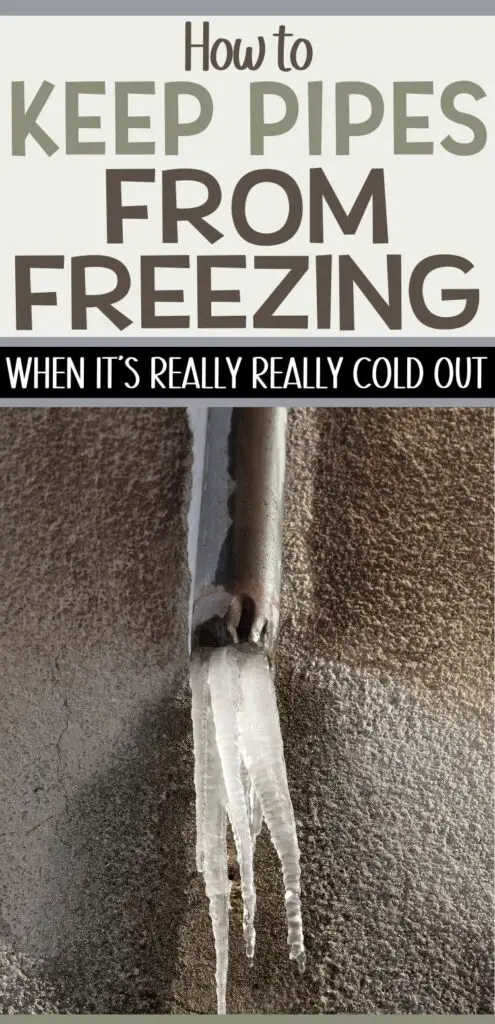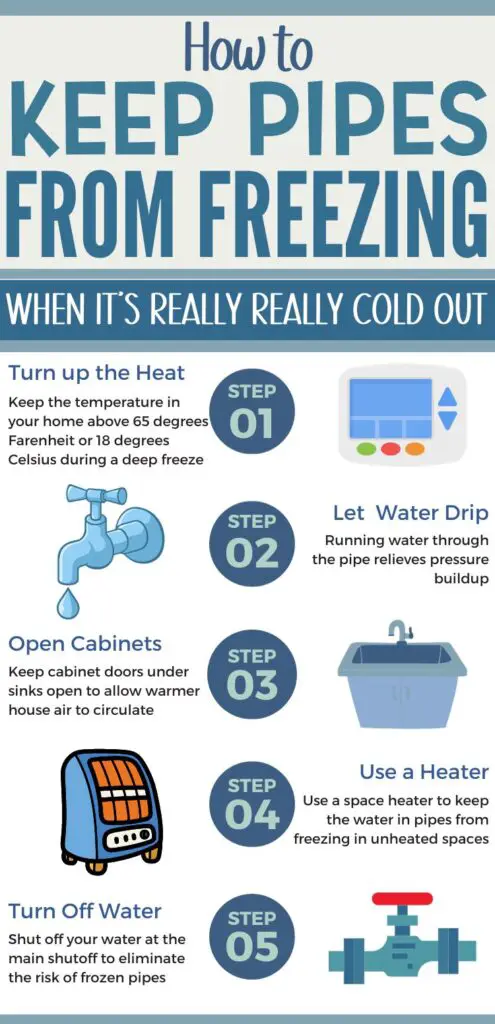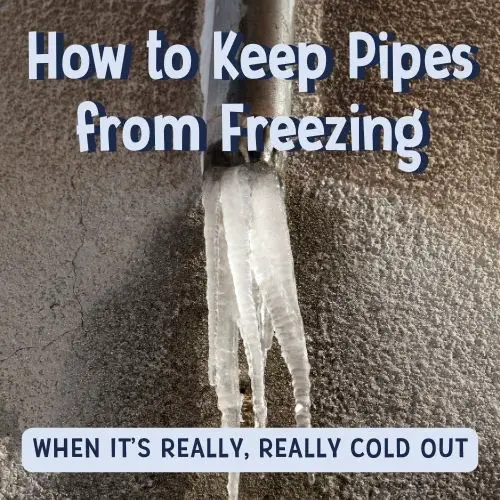As I write this post, half the country is experiencing extremely cold temperatures. And, when freezing temperatures hit, the last thing anyone wants to deal with is the inconvenience and potential damage of frozen pipes. We had a pipe burst in a crawl space in our last home that left us with a big mess and without water for days! I quickly learned and applied these tips to keep pipes from freezing to avoid having to deal with it ever again.
Frozen pipes can lead to a complete lack of water access and, in worst-case scenarios, they can burst and cause costly water damage to your home. A few preparation steps are so worth it so all you have to worry about during a deep freeze is how you can stay in your nice warm bed longer.
As an Amazon Associate I earn from qualifying purchases. This means if you click on a link and buy something I’ve recommended, I get a small commission at no additional cost to you. You can see my full Disclosure Policy here.

How to Prevent Pipes from Freezing: Quick Winter Tips
I learned that insulation is key and that wrapping pipes with foam tubing really makes a difference. And it’s not just the pipes in the garage or the basement that need attention. Any pipes running through unheated spaces (like crawl spaces) are at risk.
Running a trickle of water when the forecast calls for severe cold is another favorite tip. And leaving cabinet doors open under kitchen and bathroom sinks to keep water pipes from freezing, especially if they’re against an exterior wall.
Preparing my water pipes for winter is now a regular fall routine. It’s not just insulation and letting the faucets drip when it’s really cold – there’s more to it. From sealing those drafty areas around the pipes to knowing how to turn off the water supply in an emergency or if you’re going on vacation, these tips will help prevent frozen pipes
Why Do Water Pipes Freeze?
The primary reason pipes freeze is exposure to severe cold, especially when they’re in unheated interior spaces like basements, attics, and garages. Also, pipes located along exterior walls with inadequate insulation may freeze when the water inside drops below the freezing point – 32 degrees Fahrenheit or 0 degrees Celsius – and starts forming ice crystals. This usually happens when the outside temperature is less than -20 degrees Fahrenheit or -6 degrees Celsius.
What Happens When Water Pipes Freeze?
When pipes freeze, the risks can range from inconvenient to downright costly. Here’s what you’re potentially looking at:
- Burst Pipes: Water expands when it freezes, which increases pressure in the pipes. Expanding water can cause pipes to burst. But you might not even know it bursts until the water starts thawing and leaking out of the pipes.
- Water Damage: If a pipe bursts, it can lead to severe water damage in your home, affecting walls, floors, furniture, and even ceilings.
- Loss of Water: Frozen pipes can block water flow, impacting daily activities like washing your hands, showering, and cooking. If your pipes burst, you have to shut off the water flow and it could be days before you can get them fixed.
Tips to Prevent Frozen Pipes
Here are some home hacks I use to prevent my pipes from freezing.
Insulate Exposed Pipes
I started with insulating the pipes in your home, inside and outside – in heated and unheated areas. Insulating pipes is crucial to maintain water temperature and prevent them from freezing.
- Indoor Pipes: Protect your pipes with foam tubing or fiberglass sleeves, which are easily cut and fitted around the pipes. However, accessing the pipes is sometimes not so easy – don’t ask me how I know.
- Outdoor Pipes: For a faucet served by exposed pipes, I used heat tape to regulate the temperature. I used heavier insulation like foam rubber or polyethylene pipe insulation in the unheated crawl space.
Block Gaps that Allow Cold Air In
- Holes Around Pipes: If there are holes or any other uninsulated spaces that expose the pipes to drafts, make sure to block the cold air with some spray foam insulation or another type of insulation that will work for the space. Even a wadded-up newspaper can make a significant difference!
- Air Vents: Use foam panels to cover any crawl space vents to keep cold air out of the crawl space.

What to do Before a Cold Snap
Here are some tips to prevent your pipes from freezing during a cold snap:
Turn up the Heat
If you keep your home temperature low to save money on energy bills, this is the time to raise the temperature. Keep the thermostat set to a minimum of 65 degrees Fahrenheit or 18 degrees Celsius (professionals say 55 degrees F or 13 degrees C, but I like to stay on the safe side). Keep the temperature constant and don’t lower it at night during cold snaps. Any additional heating costs will surely be less than the expense of burst water pipes.
Keep a Tap Dripping
Let the cold water drip. It seems counterintuitive, but running water through the pipe relieves any pressure that can build up in the pipes between any potential ice blockage and the faucet. This helps to prevent the pipes from bursting when they begin to thaw. The dripping faucet should be as far away from the water source as possible so the water will flow through the entire length of the system. Any faucets on uninsulated outside walls should also drip.
Open Lower Cabinet Doors Under Faucets
Inside pipes that are located along outside walls – like in kitchens and bathrooms – are more likely to freeze and cause pipes to break. Keep cabinet doors open to allow warmer house air to circulate around the pipes under sinks and avoid frozen pipes.
Run a Space Heater
amzn.to/3O7ApEb(opens in a new tab)
If you have water pipes that go through a smaller unheated space, electric space heaters can be used to keep the water in the pipes from freezing. At our old house, we had one running close to the water intake pipe in the crawl space from December until March as a preventative measure. We currently have a space heater in the laundry room that we run to prevent washer pipes from freezing when it’s super cold out.
Turn Off Water
If you plan to be away from home for more than a night when you’re away during cold weather, it’s a good idea to completely shut off your water at the main shutoff to eliminate the risk of frozen pipes. Our main water supply comes from our well into the basement near the water heater. Leave taps open until you turn the water back on. And don’t forget to also shut off your water heater to ensure it doesn’t burn out while you are away.
RELATED POST: Do you have a cold, drafty house? Easy fixes to draft-proof your home
How Do You Know If Your Pipes Are Frozen?
If there is no water or a slow trickle when a faucet is turned on, you likely have frozen water in the pipe. If you can see frost on a pipe, it is most likely frozen.
Banging or whistling noises coming from pipes, or strange bubbling sounds when you flush the toilet are other signs a pipe may be frozen. There could also be a nasty smell coming from the drain or faucet due to the blockage.
What To Do If Water Supply Lines Freeze
When pipes freeze, acting fast reduces the risk of bursts. Here’s what to do:
Locate Frozen Pipes
Likely places for frozen pipes include against exterior walls or unheated spaces where your water service enters your home. If the water in one or two faucets runs slowly, your frozen pipe is most likely near those faucets in your home. If all the water fixtures in one room don’t run, the frozen pipe is probably near where that room’s supply line splits off.
In warmer rooms, condensation may cause small pools of water to form below a pipe. If you think you’ve located the pipe but see no obvious signs of ice, use your hands to check along sections of the pipe to find the frozen spot. Or you can use a thermal detector to find the cold spot.

Thaw Frozen Pipes
Make sure to open the faucet first as moving water helps speed up the thawing process. Apply heat to the pipe using a hairdryer. Start to thaw pipes near the faucet and work your way back to warm up your pipes. Never use open flames. Wrapping an electric heating pad around the pipe or applying heat tape also works effectively.
Continue heating the pipe until the pipes are thawed and full water pressure is restored. If your water pressure doesn’t come back to normal after heating, check all other taps in your home to find out if you have additional frozen pipes and thaw them too.
What If My Pipes Burst?
You can tell if water supply pipes have burst if you notice strange sounds coming from your plumbing or uneven water pressure from the faucets. Other signs are unpleasant odors, moldy walls, bulges, peels, or cracks, high humidity, and water-dripping sounds.
Here’s what to do when your pipes burst:
Shut Off Water Supply
Shut off the water shutoff valve immediately – it’s usually located where the main line enters the house. Turn on all the cold taps, then turn off the hot water heating system and turn on all the hot taps. Flush all the toilets in your home, too. It’s important to get all the residual water out of your pipes to help avoid further freezing, bursting, or leaking.
Stop Leaks
Apply a pipe clamp or wrap waterproof tape as a quick fix. Always keep a clamp or tape handy in cold months.
Remove Water
It is important to clean up water right away to prevent mildew and mold buildup. Use towels, buckets, mops, or a wet/dry vacuum. Do not wait for the plumber because the longer you wait the more likely it is that you’ll get mold or severe water damage.
Get Professional Help
Call a plumber. They have the right tools and expertise to safely handle serious freeze-ups and prevent future issues.
The next call you make should be to your insurance company if there has been significant water damage.
Frequently Asked Questions
Here’s some common questions and answers to help you keep your pipes from freezing:
What’s the best way to prevent indoor pipes from bursting in cold weather without any heat?
I recommend keeping cabinet doors open to allow warmer air to circulate around the plumbing, especially under sinks. Also, let a trickle of water run from the faucet farthest from where your water enters the house; this keeps water moving, making it less likely to freeze.
Can I stop my pipes from freezing up when there’s a power outage?
Yes you can! To reduce the risk during a power outage, insulate your pipes. Foam or fiberglass insulation sleeves can keep them warm. If you anticipate a long outage, let taps drip slowly, as the movement relieves pressure and helps prevent ice from forming.
Any handy DIY tips for stopping outdoor pipes from icing over?
Wrap them in heat tape before the cold hits. This tape has a built-in thermostat that turns the heat on when needed. Don’t forget to insulate any outdoor spigots and disconnect hoses too.
Is turning off the main water supply a good move to avoid pipe freezing?
Yes, if you’re leaving for an extended period during winter, turning off the main water supply and draining the system can prevent freezing and bursting. Open all faucets – hot and cold water – and flush toilets to drain the water out. Everyone should know where their main water supply valve is!
You should also turn off your water heater to prevent the motor from burning out.
Do you have any tricks for keeping pipes from freezing in less insulated areas like crawl spaces?
In crawl spaces, apply foam insulation to the pipes, and if they’re exposed to extremely cold drafts, consider adding a heat source like a heat lamp or space heater directed at the pipes, but ensure it’s safe and away from flammable materials. Leave the heat on low for the duration of the cold snap or the entire season if low temperatures are the norm.

